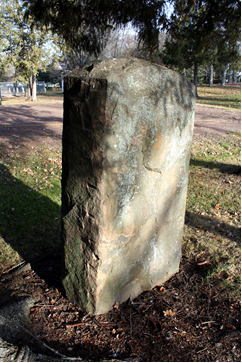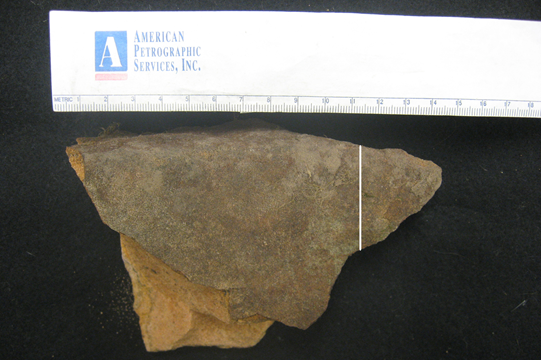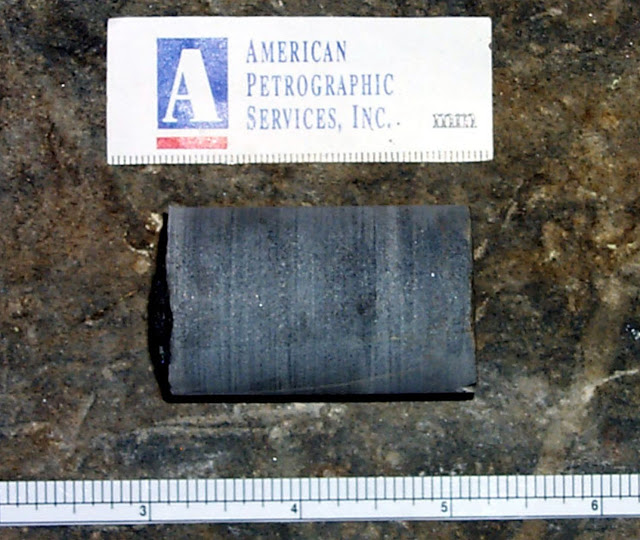Well, well, well, it’s only taken 25 years since I got involved in the world of out of place artifacts, but it’s finally happened. A mainstream archaeologist has written a 2024 paper where he concluded, although somewhat tepidly, an inscribed stone I have scientifically examined was authentic. While it really shouldn’t be a big deal, it actually is a big step in the right direction. David Mather, a National Register Archaeologist with the Minnesota State Historic Preservation Office wrote a paper about the Du Luth Stone concluding it was “More likely authentic than not.” Mather went on to say in his closing remarks, “On its own, I believe that the Du Luth Stone is likely eligible for the National Register of Historic Places as an object.” I couldn’t agree more.
This is important, and I congratulate David for having the courage to ultimately draw the correct conclusion. That said, he couldn’t help himself by including criticism of me and archaeology’s favorite whipping boy the Kensington Ruen Stone. He and his colleagues should know better than to trot out the tired and completely unsupported assertion that the artifact is a hoax. I have published numerous papers and books with voluminous conclusive evidence, in multiple disciplines (geology, words, runes, dialect, grammar, medieval Easter Table dating, medieval and late 19th Century history), the artifact is, in fact, authentic.
Instead of even mentioning one piece of evidence to support his assertion and belief, he resorts to name-calling labeling me a “pseudoarcheologist.” I was the one who took Mather to see the artifact in the first place and instead of taking the research I shared seriously; he roundly dismissed it without any intellectual curiosity or serious consideration. This is the typical of my experience with archaeologists who are incapable of thinking outside of their historical paradigm box. It’s disappointing and frankly, is a disservice to the public who pay their salaries.
I’m not going to waste the reader’s time arguing why I am right, and Mather is wrong when it comes the KRS and the Templars who carved and it along the north-south continental divide as a land claim. He, like many other archaeologists I’ve interacted with seem incapable of considering factual evidence with an open mind. It should be noted Mather confirms the Du Luth Stone, like the Kensington Rune Stone, is located along an important watershed divide. What I have done publicly in my response the Duluth Herald article that was recently published: Duluth News Article , and will do here again, is issue a challenge to Mather to join me in a public debate about the authenticity of the Kensington Rune Stone (two words). I can assure you he will decline, for when he dives into the “evidence” to support his “belief” he will find there is zero factual evidence to support a hoax. Either that, or he won’t respond at all. The lack of a response will tell us he also knows there is no evidence to support his belief, and how could there be since it is 100% a genuine medieval artifact and vitally important to not only Minnesota history, but the world history.
I’m ready when you are David…
Here is the paper I wrote about the Du Luth Stone back in 2009:
The Du Luth Stone Investigation
By Scott F. Wolter
December 21, 2009
Introduction
This report presents the results of field and laboratory work performed on an inscription carved on a glacial erratic boulder comprised of Hinckley Sandstone. The artifact was discovered near Askov, Minnesota.
Background Information
Daniel Greysolon Sieur du Luth (1636-1710), was a native of St. Germain-en-Layes, a suburb of Paris, France. According to available records, Du Luth’s first visit to New France (North America) was prior to 1674 where he joined several relatives who preceded him to old Montreal. In 1678, he resolved to explore the land of the Sioux Indians and began his journey by navigating the length of Lake Superior. From there he made his way through a tangle of rivers and lakes to discover the headwaters of the Mississippi where he planted the coat of arms of the French crown in the heart of Sioux territory.
Du Luth negotiated a strong and profitable alliance with the Sioux whose territory abounded with furs including beaver. He then visited the area of northwest Lake Superior where he was successful in negotiating peace and diverting the rich northern fur trade from routes leading to the English in Hudson Bay to those leading to the Great Lakes and the Ottawa (Wisconsin Historical Society, Document AJ-054, pages 325-328).
It was during his trek to the Mille Lacs Lake area in 1679 that he passed through the Askov area. It is possible the carving was made as part of marking a trail and/or claiming land for France.
Map of the route Daniel Greysolon Sieur Du Luth traveled through Lake Superior into Minnesota, Isle Royale and Wisconsin before returning to Montreal in 1680. The red circle indicates the area where the Du Luth Stone is located near Askov, Minnesota. (Map redrawn by Dan Wiemer from Blegen, 1975, page 47)
Site Visits
On October 16, 2009, a site visit was conducted where myself and retired professor of geology at the University of Minnesota-Duluth, Dr. Charles L. Matsch, were led to a parcel of land owned by John and Janelle Abraham, by Mr. John Ecklund, and his son Eric, to examine the inscribed boulder.
During this visit several aspects of the boulder and the inscription were documented. Numerous photographs were taken using both a 35mm digital camera and a Canon portable microscope. A hand sample of the Hinckley Sandstone was obtained from another nearby glacial boulder was also collected for laboratory analysis.
I visited the site again on November 21, 2009, with archaeologist Dave Mather, with the Minnesota State Historic Preservation Office. On this visit, we were escorted to the site by landowners John and Janelle Abraham.
After the site visit Dave Mather and I examined a large monument of Hinckley Sandstone in a park within the city limits of Askov. The monument was reported erected in 1927 (Arla Budd, 2009) and both macro and microscopic photographs were taken for relative-age weathering studies. We then visited the Askov cemetery where we located two monuments comprised of Hinckley Sandstone, dated 1927 and 2008, where additional data was collected for weathering studies.
Petrographic Analysis
On October 18, 2009, and subsequent dates, the sandstone hand sample collected was reviewed under both reflected and polarized light in accordance with ASTM: C 295 procedures. Thin section preparation and review was performed by Adam Brewer on November 23, and subsequent dates.
The rock is reddish-orange quartz arenite sandstone comprised of relatively fine-grained, well sorted and well-rounded quartz particles. The rock exhibits parting along laminar planes that likely represent bedding and has an up to 2mm thick weathering rind characterized by hematite coated grains that partly cement the quartz sand grains.
The rock is dominantly grain supported and poorly cemented by clay, hematite and syntaxial quartz overgrowths. The sample is very permeable with porosity of approximately 25%. A few areas of low porosity were observed with sutured grain boundaries suggesting low grade metamorphism.
MINERALOGY: OPTICAL PROPERTIES:
MINERALS VOL%* COLOR BIREFRINGENCE RELIEF OTHER
quartz 96-100 colorless low 1st order low dominant lithology
chert trace colorless to light brown low 1st order low
clay 2-4 light yellow to brown 1st to 2nd order low as cement
hematite trace red to red-brown or opaque masked low to medium as cement
* Based on visual estimation of thin section
Portable Microscopic Examinations
Numerous microscopic photographs were collected from the Du Luth boulder inscription and from man-made surfaces on three dated monuments comprised of Hinckley Sandstone. The focus was to document various aspects of weathering of the monuments to compare with the Du Luth boulder.
The 2008 monument exhibited sharp, well-defined boundaries along the inscribed characters with no color change due to oxidation of hematite cement. Little erosion of surficial clay and hematite cement between quartz sand grains was observed. Loss of cross-sectional area due to weathering along the carved characters was not detected.
The two sandstone monuments erected in 1927 exhibited a noticeable, yet relatively minor loss of clay and hematite cement between surficial quartz sand grains due to weathering.
The Du Luth boulder exhibited significant erosion of clay and hematite cement between surficial quartz sand grains that mimicked the glacially weathered surfaces of the boulder. The carved lines exhibited significant rounding of edges consistent with lengthy exposure to weathering.
A silica cemented dikelet bisected the boulder creating a ridge roughly 3/16” taller than the rest of the rock. This represents approximately 10-12,000 years of weathering since the boulder was deposited by the glacier giving a fixed data point for weathering.
Findings of Fact
1. The boulder is located roughly 7 miles east of Askov, Minnesota, in a relatively remote wooded area with a latitude/longitude of N 46 11.629, W 92 39.810.
2. The long axis of the boulder is aligned almost due east-west.
3. The inscription was carved into a glacial erratic boulder comprised of Hinckley Sandstone with dimensions of approximately 55" x 42" x 30."
4. The inscription carved into the boulder reads, “. 1679: Du Luth.”
5. The average height of the carved numbers in the date is approximately 3 1/4 inches, and the average height of the letter in the name is approximately 2 inches.
6. The inscription was reportedly first discovered by then landowner Nick Warabel, who was hunting and noticed the man-made carvings sometime between 1964 and 1967. He cleaned off the moss with his fingers and a hunting knife.
7. After being destroyed by the Hinckley fire in 1894, the village of Askov, Minnesota, was founded in 1906.
8. The inscribed boulder is situated along the north-south continental divide between the Great Lakes and Mississippi watersheds.
9. According to French-Canadian historian Gilles Durocher, the numbers and block-style letters are consistent with the pre-1860s French style.
10. The spelling of the French explorer’s name on the boulder, “Du Luth,” is consistent with one of the multiple known ways the explorer's name was spelled.
11. The historical record in Montreal reports that explorer Daniel Greysolon Du Luth was in the area of Minnesota in 1679.
12. The presence of two punch-style dots proximate to the inscription is consistent with other Renaissance era North American explorers such as Columbus.
13. The edges of the carved numbers and characters are significantly rounded from weathering for an unknown period of years.
14. The weathering of the man-made grooves with exposed quartz sand grains had essentially the same appearance as the glacial-age surfaces of the boulder.
15. The siliceous dikelet running through the boulder produced a 3/16” high ridge from approximately 10-12,000 years of weathering of the adjacent sandstone.
16. The weathering observed on the two monuments made of Hinckley Sandstone, erected in 1927, was significantly less advanced than the Du Luth inscription.
Interpretations
Based on our field and laboratory work, the following interpretations are appropriate:
1. The inscription was carved into a glacial erratic boulder that was likely transported from a nearby bedrock source.
2. The weathering of the Du Luth inscription is more advanced than the two sandstone monuments examined suggesting the carving is older than 1927.
3. The date inscribed on the boulder (1679) is consistent with historical accounts of Du Luth’s exploration into the Lake Superior region.
4. Since the inscribed boulder is located along the continental divide between the Great Lakes and Mississippi watersheds, it appears likely the explorer intended to mark and possibly claim the land at that specific geographic location.
Conclusion
The preponderance of the geological, historical, and geographical evidence is consistent with the Du Luth boulder having been carved by the Daniel Greysolon Sieur Du Luth exploration party at the date stated in the inscription.
Recommendations
It would seem appropriate that an archaeological investigation be conducted in the immediate vicinity of the boulder in an attempt to recover any additional artifacts that might broaden the historical context of the site. Further, it would also be helpful to obtain additional microphotographs from other dated Hinckley Sandstone examples.
References
Blegen, Theodore, Minnesota: A History of the State, Second Edition, University of Minnesota, 1963, 1975.
Matsch, Charles L. and Dr. Richard Ojakangas, Minnesota’s Geology, Univ. of Minnesota Press 1982.
Neill, Edward D., The History of the Upper Mississippi Valley, Minnesota Historical Company, 1881.
Wisconsin Historical Society, Memoir of Duluth on the Sioux Country by Daniel Greysolon Duluth, Document No. AJ-054, 1678-1682.
The inscribed boulder is a glacial erratic comprised of Hinckley Sandstone and includes the year "1679" and name "Du Luth."
Two round dots appear to have been carved to the upper left of the number "1" (top) and to the lower right of the first "U" (bottom).
A close-up view of the groove in the number "1" shows significant rounding of the carved line and significant loss of the clay cement between sand grains consistent with advanced weathering (15X).
A closer view of the wall of an inscribed groove (330 years old?). The black and green colored lichen hastens the weathering of clay cement between sand grains (60X).
A close-up view of a glacial aged surface (10-12,000 years old) shows a similar weathering profile with the same loss of the clay cement between sand grains (15X).
A closer view of the glacial aged surface (12-15,000 years old) with the loss of clay cement between sand grains. The black particles and green colored material between sand grains is lichen (60X).
The Dr. P. N. Fenger monument in the Askov City Park is comprised of Hinckley Sandstone and having been erected in 1927 serves as an excellent weathering control sample. The drill holes present on the sides indicate a man-made surface.
A close-up view of the Fenger monument surface (87 years old) shows a less advanced weathering profile with a lesser amount of the loss of the clay cement between sand grains (15X).
A closer view of the Fenger monument surface (87 years old) shows a lesser amount of the loss of clay cement between sand grains. The small black particles between sand grains are lichen (60X).
The Christian Everson monument in the Askov Cemetery is comprised of Hinckley Sandstone and having been erected in 1927 serves as a second excellent weathering control sample.
A close-up view of the Everson monument surface (87 years old) shows a less advanced weathering profile with a lesser amount of the loss of the clay cement between sand grains (15X).
A closer view of the Everson monument surface (87 years old) shows a lesser amount of the loss of clay cement between sand grains. The small black and light green particles are lichen (60X).
The Kenneth Bresin monument in the Askov Cemetery is comprised of Hinckley Sandstone and having been erected in 2008 serves as a modern weathering control sample.
A close-up view of the Bresin monument surface (1 year old) shows virtually no discernable weathering or loss of the clay cement between sand grains (15X).
A closer view of the Bresin monument surface (1 year old) shows no discernable loss of clay cement between sand grains. No black or light green colored lichen particles are visible (60X).
A closer view of carved groove of the Bresin monument exhibits a sharp and defined edge after one year of weathering (60X).
Side view of Hinckley Sandstone hand sample collected at Du Luth Stone site.
Top view of Hinckley Sandstone hand sample collected at Du Luth Stone site.
White line indicates approximate location where thin section was cut from the hand sample.
Dark reddish-black hematite cement was observed coating mostly sub to well-rounded quartz sand grains up to approximately 2 mm depth from the outer surface. Photograph taken under plane-polarized light (40X).
Abundant hematite cement was observed proximate to outer surface. See next image for zoom of red rectangle. Photograph taken under plane-polarized light (40X).
Reddish-brown hematite comprises bulk of cement between quartz sand grains. Photograph taken under plane-polarized light (200X).
Red arrows indicate clay cement in sandstone. Photograph taken under cross-polarized light (200X).
Numerous quartz grains with syntaxial overgrowths which also serve as a cementing agent. Photograph taken under cross-polarized light (100X).







































.png)
.png)
















